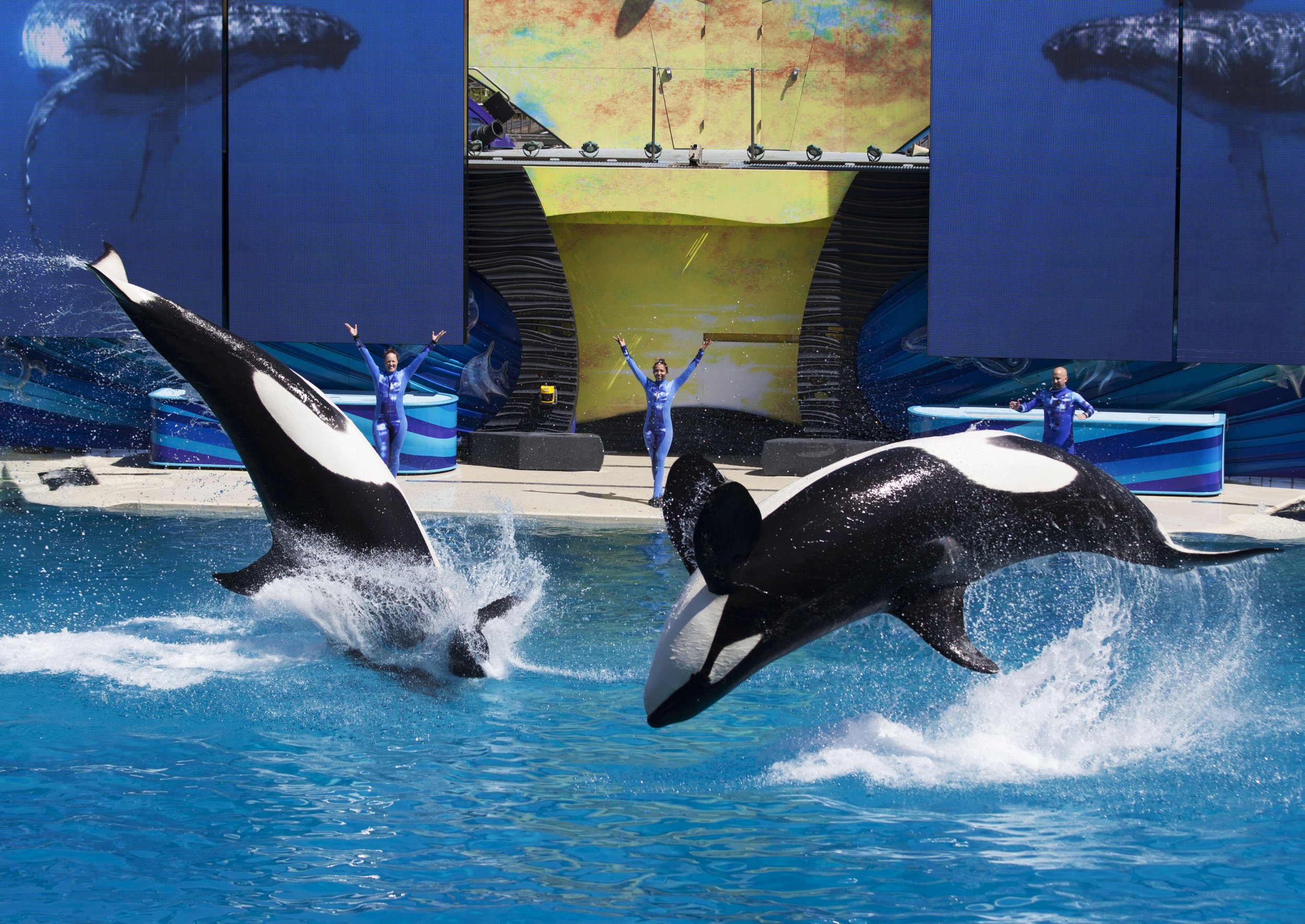How to Retire a Captive Orca: The Sea Sanctuaries of the Future

SeaWorld's Monday announcement about a change to its orca performances has not impressed the animal welfare community and animal rights groups. CEO Joel Manby said during an investor call that the company's San Diego park would "phase out theatrical killer whale show in 2016"—the show known as "One Ocean" —and replace it with a "new orca experience" in 2017.
"We are listening to our guests. We're evolving as a company. We're always changing," Manby said. "In 2017, we will launch an all-new orca experience. It's gonna be focused more on the natural setting, the natural environment and also the natural behaviors of the whale. And it'll have a strong conservation message."
But experts and activists say the orcas, or killer whales, held in captivity at SeaWorld's three parks—in San Diego, San Antonio and Orlando, Florida—are living in circumstances vastly different from their natural environment and have developed abnormal rather than natural behaviors. They've called for SeaWorld to stop breeding its orcas and retire those it currently holds in captivity.
"What you see in a concrete tank is not a normal killer whale," says Naomi Rose, a marine mammal scientist for the Animal Welfare Institute who earned her doctorate with a dissertation on the social dynamics of killer whales. In the wild, orcas are very intelligent, social animals, she says, but putting them in a concrete tank that's tiny relative to the size of their bodies is like keeping a dog in a kennel for its entire life without ever taking it for a walk or run.
"Animal rights activists, welfare organizations—anyone interested in this issue from the animal's perspective—have been asking [SeaWorld] to consider sea pen sanctuaries," Rose adds. She says SeaWorld has "adamantly refused" to discuss the matter with her or her colleagues at other organizations.
The sea pen sanctuaries are a concept similar to the land sanctuaries that are home to elephants and chimps, Rose says. In this case, however, a sea pen sanctuary would be a large space in the ocean, most likely in a bay or a cove, that is enclosed by nets.
Such a structure could be significantly larger than any tank and would allow the whales to "experience the currents and swim and dive and interact with other ocean animals," says Jared Goodman, director of animal law for People for the Ethical Treatment of Animals. "Experts agree that [the orcas] would thrive in these conditions," he adds. The whales are "suffering in captivity. There is nothing short of retiring them that would end their physical and psychological suffering."
John Hargrove worked as a killer whale trainer for 14 years, the majority of these at the SeaWorld parks in San Diego and San Antonio. He resigned in August 2012 and just days later shot an interview for Blackfish, the 2013 documentary that focuses on Tilikum, a killer whale involved in the death of trainer Dawn Brancheau and two others. The film stirred controversy for its unflattering portrayal of SeaWorld, which called it "shamefully dishonest, deliberately misleading and scientifically inaccurate."
"These animals are so incredibly bored," Hargrove tells Newsweek. "Their entire lives are these blue-walled tanks," and they "float emotionless for hours staring at a concrete wall because there's nothing for them to do." Since his resignation, Hargrove has also written Beneath the Surface: Killer Whales, SeaWorld, and the Truth Beyond Blackfish. Rose says this frustration and boredom might be why these normally active, fast-swimming, wide-ranging predators have hurt and killed people when in captivity.
Whales born and raised in captivity, or even those born in the wild but who have lived for many years in captivity, can't simply be released, Rose and Goodman both emphasize, in part because they've never had to procure their own food or develop other learned behaviors that help them survive. In the wild, killer whales live in very tight-knit social groups, but those in captivity can't necessarily join such a group upon release. The once-captive orcas remain very much dependent on human care.
The sea sanctuaries are a way for them to return to "some semblance of natural life" while still receiving the human care they need as they live out the rest of their life. Meanwhile, breeding in captivity would cease. Decades down the line, when the captive orcas are gone, the sea pens could transition into serving as rehabilitation facilities, Rose says, for injured whales that are rescued out in the wild.
Rose, Goodman and Hargrove all point to a mockup presented recently by Ingrid Visser, a researcher specializing in orcas in New Zealand waters and the founder and principal scientist for the Orca Research Trust. Her proposal involved building a sea sanctuary with medical care and other stations around an existing island and allowing public access for visitors to view and learn about the orcas in a much more natural setting.
Lori Marino, founder and executive director of the Kimmela Center for Animal Advocacy, has already assembled an expert panel to discuss in detail what such sanctuaries might look like and require, what criteria should be used to choose possible locations (such as water flow, depth and shielding from storms) and more. The group, including Rose, met for the first time this summer and will gather again in December.
Rose and Marino will also host a public workshop at a conference of the Society for Marine Mammalogy in December that "will explore the potential for the development of sea pen, retirement sanctuaries or refuges for captive cetaceans in North America."
A SeaWorld spokesman tells Newsweek via email that the orcas in San Diego will remain in the same tanks they are currently kept in for the "new orca experience" coming in 2017, and that the company plans to continue breeding the whales in captivity. The spokesman also said SeaWorld has not considered retiring its orcas or working to place them in sea pen sanctuaries, as animal welfare groups and orca experts have suggested, and pointed Newsweek to a quote from CEO Manby from the June 2015 stockholders' meeting:
First, and most importantly, our killer whales are healthy, well cared for and thriving in our care. Although animal rights critics make false allegations, there is no science to support their claims. Millions of people experience our whales annually and are inspired by them every year when they visit our SeaWorld parks. Our facilities are among the largest and most sophisticated in the world.... More than 80 percent of our whales were born in our care, and sea pens would be a poor choice for them. Uncontrollable exposure to pollution, ocean debris and life-threatening pathogens in ocean waters are just a few of the factors that make sea pens an unhealthy living environment for any of our animals.
Another SeaWorld spokesman quoted from the testimony of Hendrik Nollens, a senior veterinarian at SeaWorld San Diego, before the California Coastal Commission in October. Nollens referred to the sanctuaries as "sea cages," and otherwise echoed Manby's remarks.
"His testimony was mind-blowing to me," Rose says. "He basically said it would be a death sentence. It was just so extreme and so off-the-charts irrational." Ultimately, though, Rose and her colleagues would much rather work with SeaWorld than against it. "I want them to do this voluntarily and as partners. I don't want them to go out of business. I want them to change their business model."








